Gamification Training: Why Gamify Your Corporate Training
Gamification training incorporates competitive game-based elements into training programs to establish a fun and engaging learning environment while increasing learning engagement. Businesses must understand that they must approach engagement differently, like by gamifying their corporate training.
Today, employees expect more. Thus, corporate training has evolved significantly from the snooze-worthy seminars and training meetings of the past to fun, interactive learning.
In this article, we’ll discuss how gamification training is important in corporate settings, how to gamify training, which type of training strategy can be used, the challenges it faces, and how effective it is.
Table of Contents
- What is gamification in employee training?
- Types of corporate training that can be gamified
- Benefits of gamification training
- How do you gamify a training session?
- What is an example of gamification training?
- Challenges of gamification training
- How effective is gamification in training?
- Conclusion
- Machine Learning In Finance: 12 Essential Applications
- How To Create Interactive Compliance Training For Bank Employees
- How Fintech Apps Are Using Gamification To Increase User Engagement
- Top Gamification Companies for Employee & Customer Engagement
Download your free
“Gamification Guide”
Get your PDF now and start transforming your approach to digital engagement!
What is gamification in employee training?
In corporate training, gamification creates game-like situations and challenges in a risk-free learning atmosphere. Employees learn through interactive training activities rather than lectures.
Gamification elements/ techniques can be used to build a game like Duolingo. Most corporations generally integrate gamification into existing systems or their learning management systems (LMS) using software like Mambo.
Consider Duolingo as an excellent example of gamification. Since 2011, this app has received over 500 million downloads, with 40 million active monthly users using it to learn their preferred language.
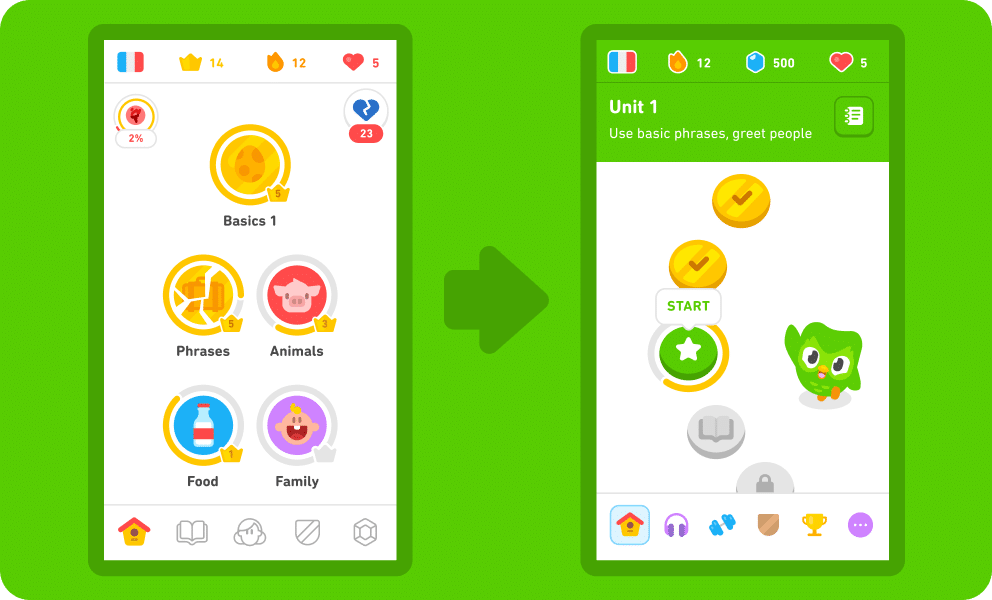
Daily goals, leaderboards, and badges motivate people to learn and use new words in sentences. As a result, learning a language becomes an activity that is enjoyable, competitive, and rewarding.
Types of corporate training that can be gamified
Gamifying training may benefit almost all departments and corporate needs. This is from your training routines to onboarding orientations to technical training.
#1. Onboarding and orientation
Domino’s, one of the world’s most well-known pizza companies, required a new way to improve its onboarding and training process. They invested in a gamified learning system that used bite-sized modules to train and assess employees on new skills to address this need.
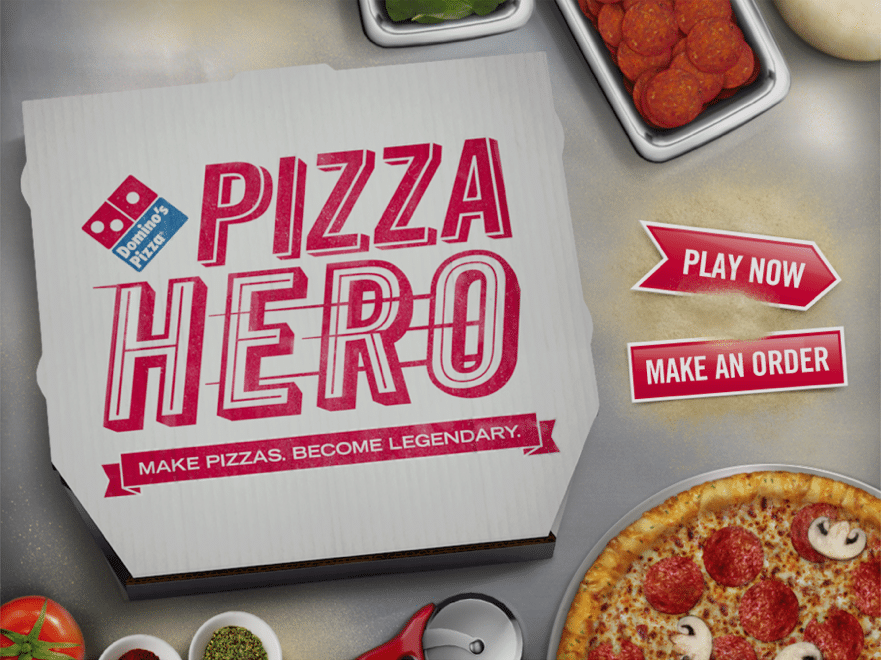
In 2015, they released Pizza Hero, a gamified mobile app (for employees and customers) with timed challenges and rewards. Upon its release, this resulted in a 30% increase in sales. Domino’s also saw a quicker path to competency for newly-hired employees.
#2. Compliance training
This is one of the most difficult and time-consuming training modules for any company. Compliance training ensures that your employees understand and abide by the rules and regulations of the company.
These trainings are usually required and often seem “boring’ and/or ‘not that engaging.’
For example, UK’s mobile network giant, EE created an interactive platform for both compliance and digital skills improvement. The Digital Academy included micro-courses and game-like quizzes. Their employees’ assessment scores averaged up to 99% because of this.

Source: Digital Academy
But, there are now ways to improve training. You can create safety games to see who knows the most about the new state laws for your industry.
For example, Sweden’s Speed Camera Lottery gathers all of those who obey the traffic rules. These are then entered into a lottery to win cash prizes. This reduced the speed of Swedish drivers by 22%.
#3. Sales training
Gamification in training can help your sales teams be more effective. Take SAP as an example. They have a large sales force and are constantly releasing new products. To effectively sell these new offerings, the sales team must master them.
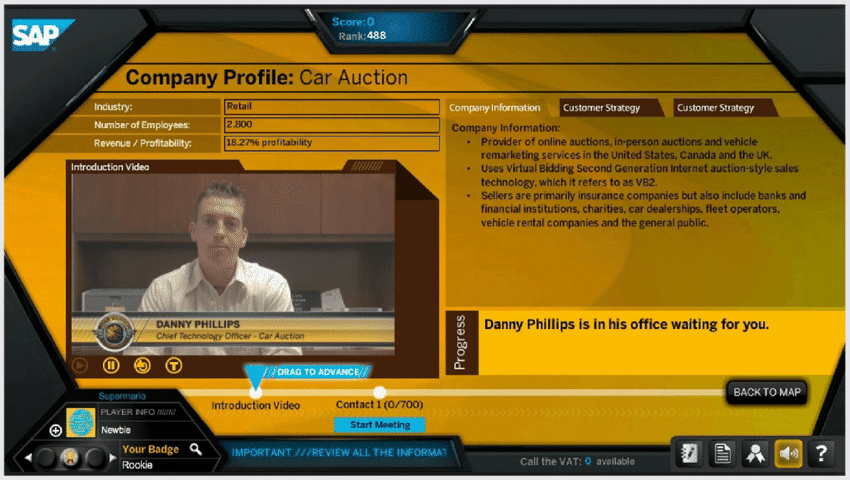
As a result, SAP introduced Road Warrior, a gamification tool. This app provides multiple choice-style games where sales team members compete to be the top product expert.
The game intends to teach about the most recent technological products while simulating a typical sales encounter with a potential customer.
This gives healthy competition while sales team members memorize new product offerings. They also gain more tips to sell these new products to new customers effectively.
Download your free
“108 Gamification Elements and Mechanics”
Get your cheat sheet and have a quick reference at your fingertips!
#4. Customer service training
Gamification can help improve contact centre performance. Call centre gamification creates an interactive digital environment where agents work to complete their ‘missions.’
For instance, 200 quality points could redeem a movie ticket or a vacation day. The bonus structure converts employers’ appreciation into tangible rewards for them.
#5. Leadership training
Leadership development is all about being creative. After all, you are the one who teaches by example. Provide fun, gamified ways for employees to grow or enhance their abilities. That way, they will respond positively.
People like “levelling up” rather than moving toward their careers. You give them exactly that when you gamify corporate training. Departments can even be teamed up to create various games and competitive activities.
#6. Soft skills training
Manufacturing giant Siemens used gamification to make their operations managers more efficient. PlantVille was the game they used. It is like the popular Zynga game FarmVille.
The game simulates their daily job responsibilities. And they must make decisions based on the best plan for their plant.

This game aims to teach them about Siemens’ products and solutions. This is while instilling important behavioural changes for job success. Quality, satisfaction, safety, and timeliness are considered when evaluating players.
#7. Technical training
Gamification can be used in training to roll out a new software program.
For example, MessageOps began using Office 365 to manage everyday tasks. It gamified the software to encourage its employees to learn and use it.
Employees who mastered a new software section received badges, prizes, and company recognition. A leaderboard also displays top performers, instilling competition among employees.
#8. Safety training
Gamification has the significant advantage of facilitating safety training. It encourages the development of habits. This includes double-checking the sender of emails they receive. Employees could also help check suspicious requests for private data before responding.

A good example would be creating an email. Employees must identify elements that show it is bogus or a phishing attempt. Each correct identification earns the employees points. The points will help them move up the leaderboard.
A game like this can train them to be more alert to phishing emails in the real world.
Benefits of gamification training
Training gamification tactics can help you work on training initiatives and business goals. Here are reasons why gamification is an excellent corporate training tool.
#1. Increased Engagement
You might be worrying about your employees paying attention in a training session. With gamification, you can rest assured that everyone is engaged and having a great time in the learning program. This assures that people are learning rather than simply attending training.
#2. Better Information Retention
People learn more easily when something is interactive and enjoyable. People learn faster with all the games and interactive methods they use. Making learning more enjoyable is an excellent way to improve employee learning retention.
#3. Improved Collaboration
To encourage social activity- points, and rewards can be used. Similarly, collaboration and knowledge shared via interactive methods foster community spirit.
As a result, a strong learning culture is fostered.
#4. Greater Motivation
Gamifying your corporate training creates engaged employees motivated to complete their training modules. According to a study, gamified apps influence behaviour twice as much as other methods.
How do you gamify a training session?
You can gamify your corporate training by incorporating game mechanics into your lessons. Game mechanics regulate, control, and guide the player’s actions. Here are some tips for creating a gamified training session.
Set clear objectives
Determine the training goals and what the employee will learn from the training. Ensure that these objectives are consistent with the larger business objectives.
Create your gamification and training strategy after you’ve determined your goals. Choose game mechanics that correspond to your training objectives.
Keep it simple
Challenging game mechanics encourage employees to be more involved with training. But, an excessively difficult level can lead to frustration. Employee training engagement may suffer as a result.
Avoid using too many gaming elements. Create a gamification strategy that is appropriate for your employees’ learning levels.
Offer rewards
Training gamification provides awards in the same way that advances at a video game level do. Examine your training sessions to see where you can incorporate these. It could be badges, recognition, or a perk for employees, such as an extra day off. This could be taken a step further by implementing a formal point system.
For example, each level of points earned earns a specific reward. A company-wide publication may feature the top employees to encourage others to follow.
Provide feedback
Gamification training provides feedback throughout a training course. This ensures that teams continue to learn as they advance through the course. It also aids in the learning of more complex topics. This ensures that basic concepts are understood first.
After receiving feedback on these simpler concepts, work on changes. And employees are ready to build on the fundamentals.
What is an example of gamification training?
There are several ways to incorporate gamification concepts and methods into a training program. This ranges from naming a top performer to organizing learning contests. Gamification training software like Mambo.io can help your company create these.
#1. Adventure paths
A learning path is a set of tasks or obstacles that must be completed individually in a specific order. That’s so employees could be assessed as a master or certified in that topic.
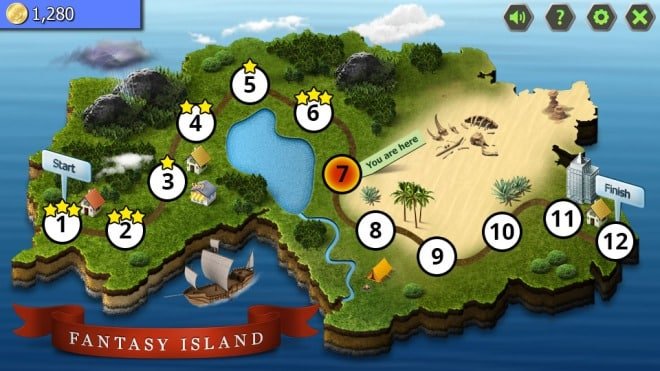
Gamification allows employees to track their progress and review the most difficult topics. You can also use the points systems or provide certificates upon successful completion.
#2. Roleplay
Put an internal leaderboard so employees can see who excels in their learning paths. Encourage them with awards at different milestones. This motivates them to see their names rise to the top of the leaderboard.
Continuously monitor and revise
Gamification in training is not a one-size-fits-all solution. You have to revise it depending on your employees’ needs continuously. What worked before may not work in your next training. So, ensure that you personalize them to ensure engagement.
Challenges of gamification training
Gamification proves to be an effective and adaptable tool for improving corporate training. These methods keep employees engaged and eager to learn more. Below are gamification examples that successfully met their training objectives.
-
Over-gamification
There is such a thing as ‘trying too hard’ in gamification. That’s especially if you are so focused on the idea of fun that you overlook the point of training. While entertainment is important, the subject matter must remain relevant.
-
Lack of clear goals and objectives
Organizing game-based training is fantastic– unless your learners don’t understand the purpose. Employees may lose interest without clear game goals. That’s if there aren’t target scores and outcomes. They may lose motivation without clear rewards, like badges and prizes.
Both goals and rewards are important during the game’s planning and development stages.
-
Limited resources
Creating gamification training materials for your employees may be costly. Gamified training may end up being poorly executed because of the limited budget. Other than that, coding skills may be required for you to achieve such. In cases like this, use a gamification learning platform to ease the process.
How effective is gamification in training?
Gamification proves to be an effective and adaptable tool for improving corporate training. These methods keep employees engaged and eager to learn more. Below are gamification examples that successfully met their training objectives.
#1. PwC
Gamification was used in PwC’s recruitment process. Job candidates go on a virtual reality simulation of being a company employee in a game called Multipoly. The simulation included negotiating with fictitious clients and playing various company roles.

The game mechanics increased their pool of job candidates by 190%. There was also an increase in interest in working for PwC by 78%, according to statistics.
#2. Deloitte
Gamification is used in Deloitte’s leadership training. It consists of video lectures, tests, and quizzes. It also has missions and badges to improve the retention of its training courses.
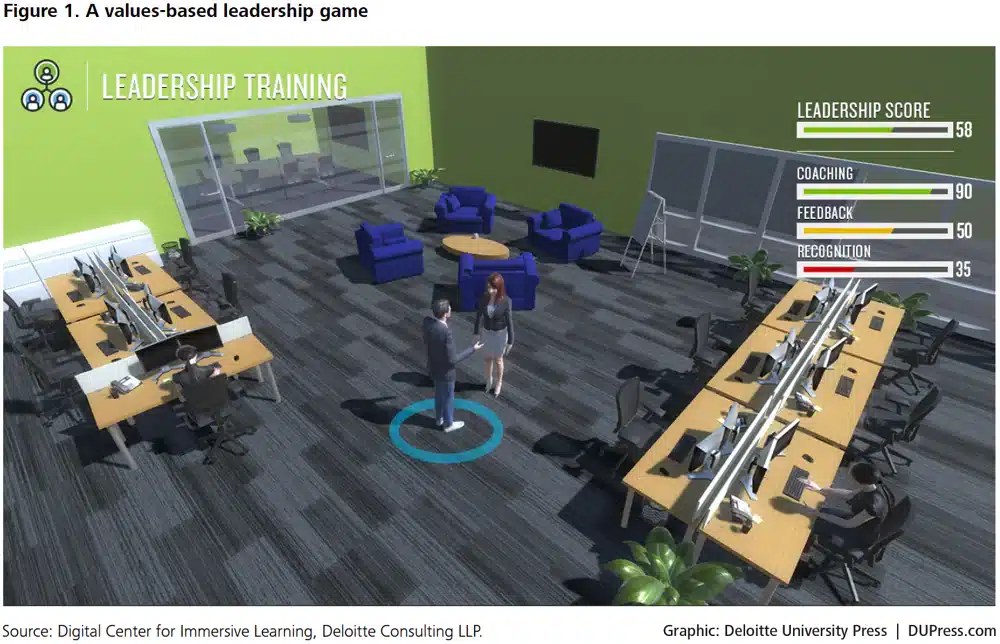
A badge was awarded to each participant who completed learning. And their leaderboard is reset every seven days to provide newcomers with a fair shot at the top.
Deloitte faced difficulties in motivating its leadership to finish the training before. And based on statistics, gamification in corporate training has resulted in a 47% increase in return users.
#3. AstraZeneca
AstraZeneca used gamification to educate their staff, including a new medicine line. They created the ‘Go-to-Jupiter’ training for this.
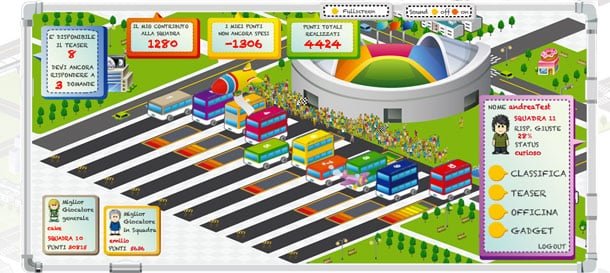
The game used game mechanics such as rewards, leaderboards, and team-building competitions. It also had levels to excite salespeople about the new product launch. They could also check the training results in real time.
Over 95% of participants completed the training module due to the gamification efforts. And 97% of people were engaged. Employees also completed the outside regular working hours. That only indicates their employees’ strong desire to learn.
Conclusion
Games have been shown to improve learning retention. It provides a healthy level of competition for teams. And it is a great way for employees to feel connected and engaged. This makes learning more enjoyable in a stressful world.
This can be highly achieved through gamification strategies for your corporate training. That’s as long as it’s not overly ‘gamified’. Such gamification training tools like Mambo.io can help your company achieve that.
Mambo.io is a gamification software that provides gamified training solutions not only for employees but also for direct customers, soccer fans, and audiences who want to gamify their training.
It has powerful tools to assist in creating effective and engaging games for any metric. This helps you save time when designing your company’s gamification strategy.
Latest Posts
Machine Learning In Finance: 12 Essential Applications
The impact of machine learning on finance is significant. Thanks to this technology, financial institutions are now equipped to make efficient decisions. Through the analysis of data sets, machine learning […]
How To Create Interactive Compliance Training For Bank Employees
Banking compliance training isn’t just another task. It’s the stage where everything else performs. Banks must navigate a myriad of regulations and laws. After all, this is a trust-driven, high-stakes […]
How Fintech Apps Are Using Gamification To Increase User Engagement
Discover how gamification in fintech is revolutionizing financial engagement, making banking fun & boosting user loyalty.






